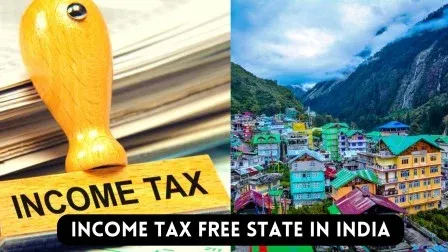Under the Income Tax Act of India, every individual is required to pay taxes. This means that everyone has to pay taxes directly or indirectly. Yet, did you know that there is one Indian state where people are not required to pay taxes? Keep reading to find out which state it is and why its people are tax-exempt. Discover which state in India enjoys the tax-free status and what makes it unique!
Every state in India requires its residents to pay taxes for the use of amenities, whether paid directly or indirectly. Yet, there is a state in India where people are not required to pay taxes. Today, we'll tell you about one such state in the country, where individuals haven't been paying taxes for years. To learn where this state is and why its residents do not pay taxes, read the entire article. Discover the reasons behind the tax-free status of this state in India and how it impacts its residents.
Which State is Tax-Free in India?
Sikkim is the only state in India where native residents are exempt from paying income tax. However, this privilege is only applicable to the original residents of the state. Learn more about this tax-free status and how it benefits the native residents of Sikkim by reading the full article. Learn why Sikkim is India's only state without an income tax and how it affects the lives of its citizens.
Why Sikkim is Tax-Free State
Sikkim, a state located in the northeastern region of India, is exempted from income tax for its original inhabitants under Section 10(26AAA) of the Income Tax Act, 1961. This exemption allows the people residing in Sikkim to not pay any type of tax on their income. It's important to note that all northeastern states of India are designated as special states under Article 371-F. This is the reason why people from other states cannot purchase any type of property, residential or commercial, in Sikkim. To know more about this tax exemption and Sikkim's special status, read the complete article.
Earlier Limited People Were Eligible For Tax Exemption
The exemption was previously confined to a certain category of persons under the Income Tax Act. In Sikkim, only those who held a Sikkim Subject Certificate were eligible for this exemption. However, after a Supreme Court order in 1989, other people were also included, and the number of beneficiaries increased to 95%. This exemption provides major benefits to Sikkim residents because they do not have to pay income tax on their profits. It is important to note that Sikkim is a special state under Article 371-F, which grants it special status and certain privileges. This has also led to restrictions on non-Sikkim residents from buying property in the state.
Tax exemption is available on condition in Sikkim
When Sikkim became a part of India, it did so with certain conditions, including a condition regarding taxes. This is why tax exemptions in Sikkim are subject to certain conditions. In fact, the Sikkim Manual Tax was issued in 1948.
Sikkim Completely Merged With India on 26 April 1975
The first Prime Minister of India, Pandit Jawaharlal Nehru proposed to establish Sikkim and Bhutan as Himalayan states under India. In this regard, an agreement was signed in 1948, and finally, in 1950, Sikkim became a part of India completely. At that time, its ruler was Chogyal. However, the day of 26th April 1975 was the day when Sikkim was completely merged into India. On May 16, 1975, Sikkim became India's 22nd state. Sikkim has been a part of India since then, and it is also recognized for its gorgeous valleys.
Conclusion
Sikkim is the only state in India where original inhabitants are exempt from paying income tax, and this exemption is granted under Section 10(26AAA) of the Income Tax Act, 1961. This exemption has benefited the people of Sikkim significantly, as they do not have to pay any tax on their income. However, it is important to note that this tax exemption is subject to certain conditions, and non-Sikkim residents cannot purchase any property in the state. Sikkim became a part of India in 1950, and it was fully merged into India on April 26, 1975, becoming India's 22nd state.
FAQs
Q1. Why is Sikkim tax-free?
Answer- Sikkim became a part of India in 1975, with Chogyal as its ruler. He had introduced the Sikkim Income Tax Manual in 1948, which granted income tax exemption to the people of Sikkim. When Sikkim merged with India, this exemption continued to apply to the Sikkimese people.
Q2. Which city is tax-free?
Answer- Saint Kitts and Nevis: Saint Kitts and Nevis is a beautiful island country in the Caribbean, famous for its stunning beaches and warm climate. The best part is, this country doesn't have any personal income tax, capital gains tax or inheritance tax!
Q3. What is the most tax-free state?
Answer- Which states in the USA are tax-free? As of 2022, Alaska, Florida, Nevada, New Hampshire, South Dakota, Tennessee, Texas, Washington, and Wyoming do not charge a state income tax.
Q4. Is India a tax-free country?
Answer- If you live in India and are considered a Resident, then you have to pay taxes in India.
Q5. Which state is GST-free?
Answer- The states of Arunachal Pradesh, Jammu and Kashmir, Himachal Pradesh, Uttarakhand, Tripura, Nagaland, Sikkim, Meghalaya, Mizoram, Assam, and Manipur are categorized as hilly and north-eastern states and are exempted from paying Goods and Services Tax (GST).
Q6. Is Goa tax-free?
Answer- Just like in other states, Goa has taxes that depend on different factors like the cost, age, engine power, length, and width of the vehicle. People who own a vehicle, whether it is a two-wheeler or a four-wheeler, are required to pay road tax. So, Goa is not a tax-free state.

Comments
Post a Comment
Please do not enter any spam link in the comment box.